Industrial Engineering Report: Pilot Translating Earpiece Analysis
VerifiedAdded on 2020/04/01
|10
|2217
|227
Report
AI Summary
This report presents an industrial engineering analysis of the Pilot Translating Earpiece, a product designed to satisfy human needs through real-time language translation. The report begins by selecting the smart earpiece as the product and discusses the challenges in its development, including high research costs and consumer behavior. It then outlines the Integrated Product and Process Development (IPPD) principles, such as integrated teaming and concurrent engineering, and describes the phases of product realization, focusing on customer focus and lifecycle planning. The report lists the engineering design steps, including concept and feasibility studies, market research, and prototype development. It also details the manufacturing processes required, such as casting, molding, and additive manufacturing, and illustrates the integrated product development process, emphasizing customer needs, product development teams, and robust design. The conclusion highlights the evolution of machine translation and summarizes the key aspects of the IPPD approach for the smart earpiece.

Pilot Translating Earpiece
Industrial engineering
Name of the student:
Name of the university:
Author Note
Industrial engineering
Name of the student:
Name of the university:
Author Note
Secure Best Marks with AI Grader
Need help grading? Try our AI Grader for instant feedback on your assignments.
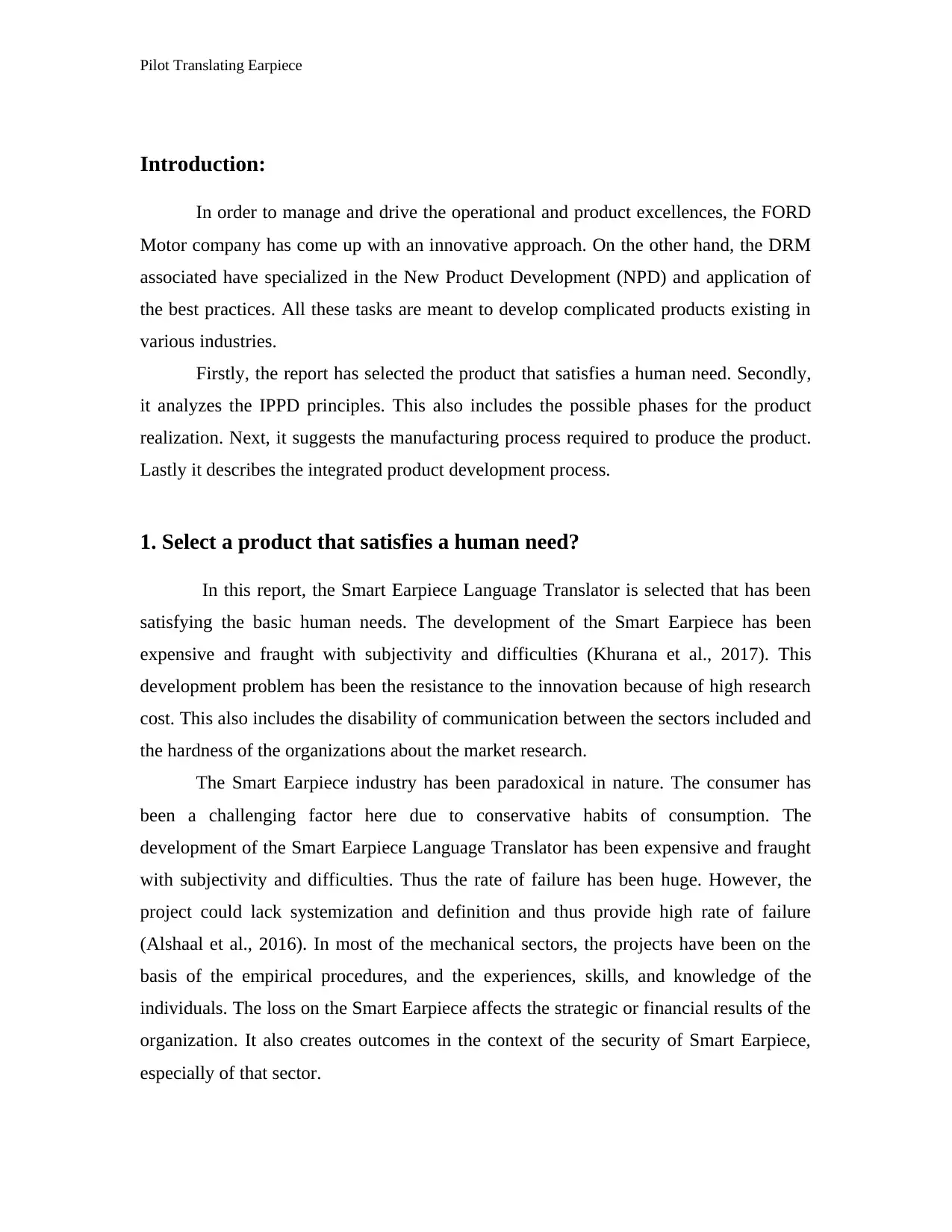
Pilot Translating Earpiece
Introduction:
In order to manage and drive the operational and product excellences, the FORD
Motor company has come up with an innovative approach. On the other hand, the DRM
associated have specialized in the New Product Development (NPD) and application of
the best practices. All these tasks are meant to develop complicated products existing in
various industries.
Firstly, the report has selected the product that satisfies a human need. Secondly,
it analyzes the IPPD principles. This also includes the possible phases for the product
realization. Next, it suggests the manufacturing process required to produce the product.
Lastly it describes the integrated product development process.
1. Select a product that satisfies a human need?
In this report, the Smart Earpiece Language Translator is selected that has been
satisfying the basic human needs. The development of the Smart Earpiece has been
expensive and fraught with subjectivity and difficulties (Khurana et al., 2017). This
development problem has been the resistance to the innovation because of high research
cost. This also includes the disability of communication between the sectors included and
the hardness of the organizations about the market research.
The Smart Earpiece industry has been paradoxical in nature. The consumer has
been a challenging factor here due to conservative habits of consumption. The
development of the Smart Earpiece Language Translator has been expensive and fraught
with subjectivity and difficulties. Thus the rate of failure has been huge. However, the
project could lack systemization and definition and thus provide high rate of failure
(Alshaal et al., 2016). In most of the mechanical sectors, the projects have been on the
basis of the empirical procedures, and the experiences, skills, and knowledge of the
individuals. The loss on the Smart Earpiece affects the strategic or financial results of the
organization. It also creates outcomes in the context of the security of Smart Earpiece,
especially of that sector.
Introduction:
In order to manage and drive the operational and product excellences, the FORD
Motor company has come up with an innovative approach. On the other hand, the DRM
associated have specialized in the New Product Development (NPD) and application of
the best practices. All these tasks are meant to develop complicated products existing in
various industries.
Firstly, the report has selected the product that satisfies a human need. Secondly,
it analyzes the IPPD principles. This also includes the possible phases for the product
realization. Next, it suggests the manufacturing process required to produce the product.
Lastly it describes the integrated product development process.
1. Select a product that satisfies a human need?
In this report, the Smart Earpiece Language Translator is selected that has been
satisfying the basic human needs. The development of the Smart Earpiece has been
expensive and fraught with subjectivity and difficulties (Khurana et al., 2017). This
development problem has been the resistance to the innovation because of high research
cost. This also includes the disability of communication between the sectors included and
the hardness of the organizations about the market research.
The Smart Earpiece industry has been paradoxical in nature. The consumer has
been a challenging factor here due to conservative habits of consumption. The
development of the Smart Earpiece Language Translator has been expensive and fraught
with subjectivity and difficulties. Thus the rate of failure has been huge. However, the
project could lack systemization and definition and thus provide high rate of failure
(Alshaal et al., 2016). In most of the mechanical sectors, the projects have been on the
basis of the empirical procedures, and the experiences, skills, and knowledge of the
individuals. The loss on the Smart Earpiece affects the strategic or financial results of the
organization. It also creates outcomes in the context of the security of Smart Earpiece,
especially of that sector.
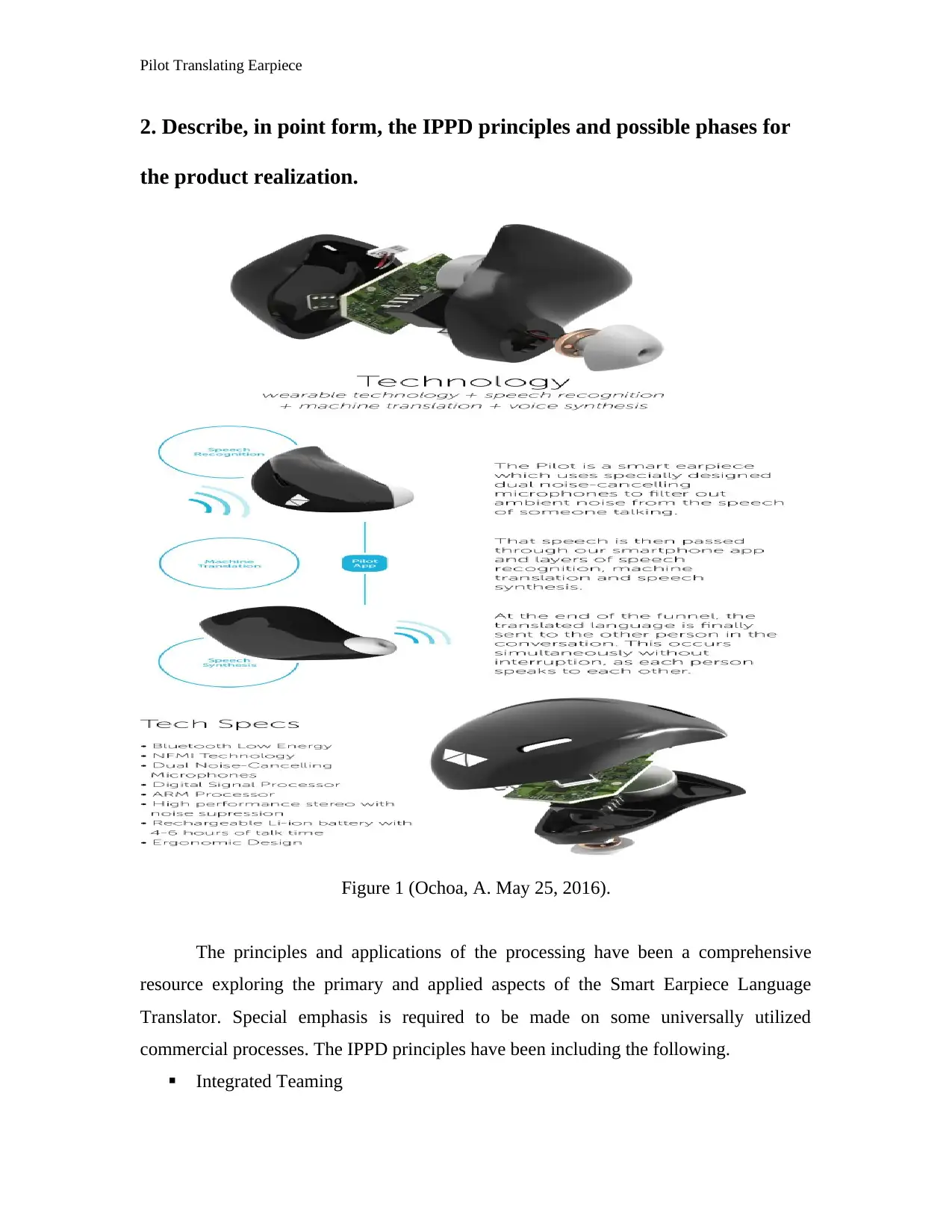
Pilot Translating Earpiece
2. Describe, in point form, the IPPD principles and possible phases for
the product realization.
Figure 1 (Ochoa, A. May 25, 2016).
The principles and applications of the processing have been a comprehensive
resource exploring the primary and applied aspects of the Smart Earpiece Language
Translator. Special emphasis is required to be made on some universally utilized
commercial processes. The IPPD principles have been including the following.
Integrated Teaming
2. Describe, in point form, the IPPD principles and possible phases for
the product realization.
Figure 1 (Ochoa, A. May 25, 2016).
The principles and applications of the processing have been a comprehensive
resource exploring the primary and applied aspects of the Smart Earpiece Language
Translator. Special emphasis is required to be made on some universally utilized
commercial processes. The IPPD principles have been including the following.
Integrated Teaming
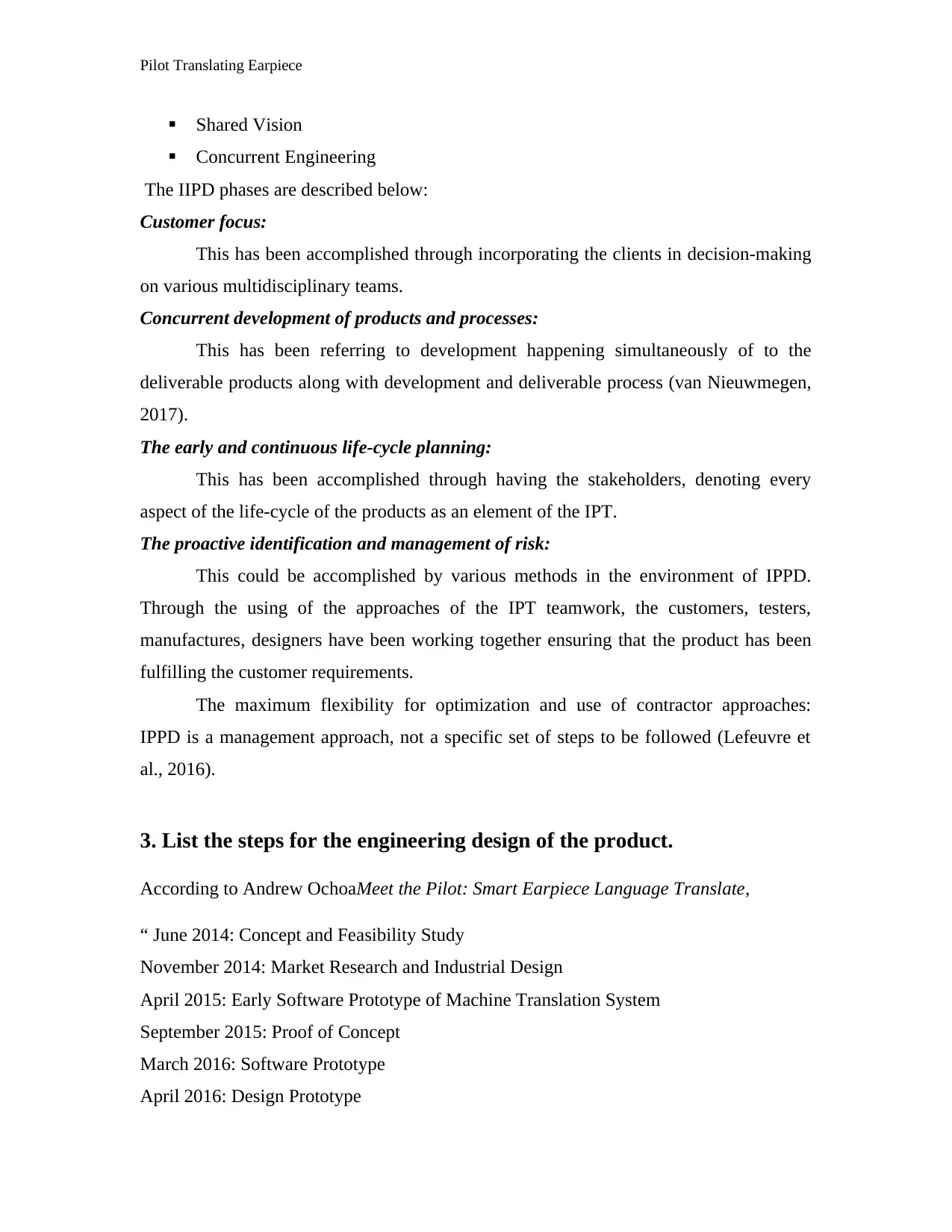
Pilot Translating Earpiece
Shared Vision
Concurrent Engineering
The IIPD phases are described below:
Customer focus:
This has been accomplished through incorporating the clients in decision-making
on various multidisciplinary teams.
Concurrent development of products and processes:
This has been referring to development happening simultaneously of to the
deliverable products along with development and deliverable process (van Nieuwmegen,
2017).
The early and continuous life-cycle planning:
This has been accomplished through having the stakeholders, denoting every
aspect of the life-cycle of the products as an element of the IPT.
The proactive identification and management of risk:
This could be accomplished by various methods in the environment of IPPD.
Through the using of the approaches of the IPT teamwork, the customers, testers,
manufactures, designers have been working together ensuring that the product has been
fulfilling the customer requirements.
The maximum flexibility for optimization and use of contractor approaches:
IPPD is a management approach, not a specific set of steps to be followed (Lefeuvre et
al., 2016).
3. List the steps for the engineering design of the product.
According to Andrew OchoaMeet the Pilot: Smart Earpiece Language Translate,
“ June 2014: Concept and Feasibility Study
November 2014: Market Research and Industrial Design
April 2015: Early Software Prototype of Machine Translation System
September 2015: Proof of Concept
March 2016: Software Prototype
April 2016: Design Prototype
Shared Vision
Concurrent Engineering
The IIPD phases are described below:
Customer focus:
This has been accomplished through incorporating the clients in decision-making
on various multidisciplinary teams.
Concurrent development of products and processes:
This has been referring to development happening simultaneously of to the
deliverable products along with development and deliverable process (van Nieuwmegen,
2017).
The early and continuous life-cycle planning:
This has been accomplished through having the stakeholders, denoting every
aspect of the life-cycle of the products as an element of the IPT.
The proactive identification and management of risk:
This could be accomplished by various methods in the environment of IPPD.
Through the using of the approaches of the IPT teamwork, the customers, testers,
manufactures, designers have been working together ensuring that the product has been
fulfilling the customer requirements.
The maximum flexibility for optimization and use of contractor approaches:
IPPD is a management approach, not a specific set of steps to be followed (Lefeuvre et
al., 2016).
3. List the steps for the engineering design of the product.
According to Andrew OchoaMeet the Pilot: Smart Earpiece Language Translate,
“ June 2014: Concept and Feasibility Study
November 2014: Market Research and Industrial Design
April 2015: Early Software Prototype of Machine Translation System
September 2015: Proof of Concept
March 2016: Software Prototype
April 2016: Design Prototype
Secure Best Marks with AI Grader
Need help grading? Try our AI Grader for instant feedback on your assignments.
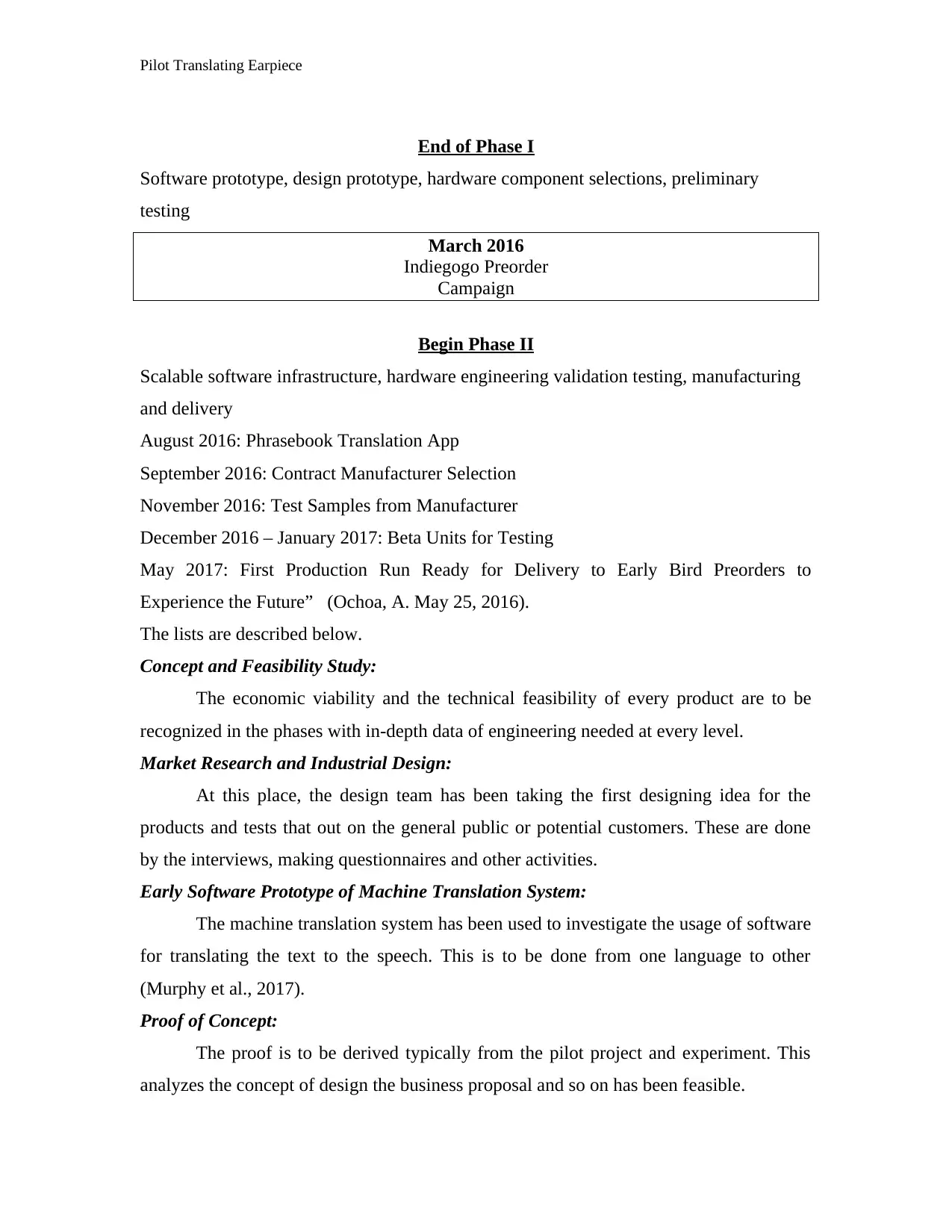
Pilot Translating Earpiece
End of Phase I
Software prototype, design prototype, hardware component selections, preliminary
testing
March 2016
Indiegogo Preorder
Campaign
Begin Phase II
Scalable software infrastructure, hardware engineering validation testing, manufacturing
and delivery
August 2016: Phrasebook Translation App
September 2016: Contract Manufacturer Selection
November 2016: Test Samples from Manufacturer
December 2016 – January 2017: Beta Units for Testing
May 2017: First Production Run Ready for Delivery to Early Bird Preorders to
Experience the Future” (Ochoa, A. May 25, 2016).
The lists are described below.
Concept and Feasibility Study:
The economic viability and the technical feasibility of every product are to be
recognized in the phases with in-depth data of engineering needed at every level.
Market Research and Industrial Design:
At this place, the design team has been taking the first designing idea for the
products and tests that out on the general public or potential customers. These are done
by the interviews, making questionnaires and other activities.
Early Software Prototype of Machine Translation System:
The machine translation system has been used to investigate the usage of software
for translating the text to the speech. This is to be done from one language to other
(Murphy et al., 2017).
Proof of Concept:
The proof is to be derived typically from the pilot project and experiment. This
analyzes the concept of design the business proposal and so on has been feasible.
End of Phase I
Software prototype, design prototype, hardware component selections, preliminary
testing
March 2016
Indiegogo Preorder
Campaign
Begin Phase II
Scalable software infrastructure, hardware engineering validation testing, manufacturing
and delivery
August 2016: Phrasebook Translation App
September 2016: Contract Manufacturer Selection
November 2016: Test Samples from Manufacturer
December 2016 – January 2017: Beta Units for Testing
May 2017: First Production Run Ready for Delivery to Early Bird Preorders to
Experience the Future” (Ochoa, A. May 25, 2016).
The lists are described below.
Concept and Feasibility Study:
The economic viability and the technical feasibility of every product are to be
recognized in the phases with in-depth data of engineering needed at every level.
Market Research and Industrial Design:
At this place, the design team has been taking the first designing idea for the
products and tests that out on the general public or potential customers. These are done
by the interviews, making questionnaires and other activities.
Early Software Prototype of Machine Translation System:
The machine translation system has been used to investigate the usage of software
for translating the text to the speech. This is to be done from one language to other
(Murphy et al., 2017).
Proof of Concept:
The proof is to be derived typically from the pilot project and experiment. This
analyzes the concept of design the business proposal and so on has been feasible.
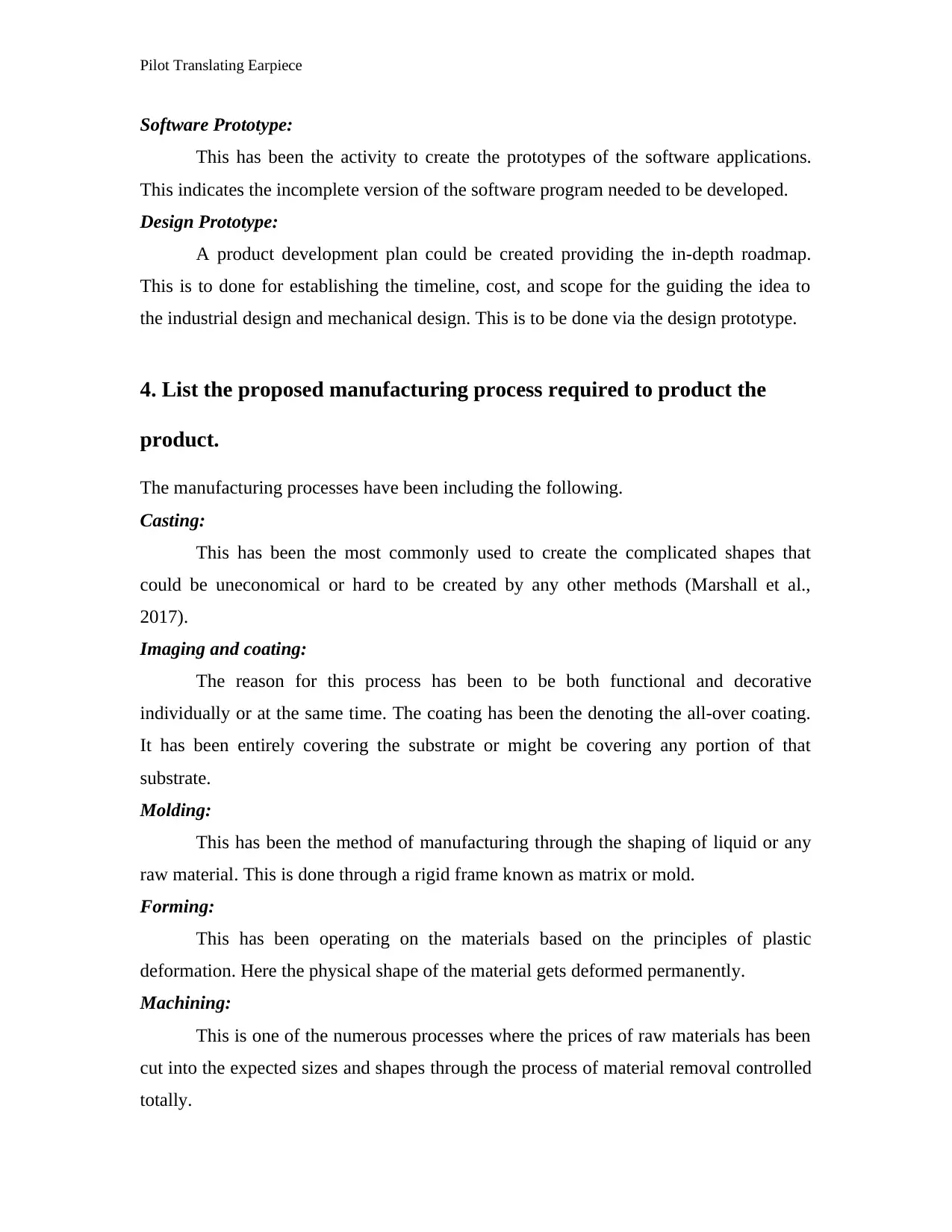
Pilot Translating Earpiece
Software Prototype:
This has been the activity to create the prototypes of the software applications.
This indicates the incomplete version of the software program needed to be developed.
Design Prototype:
A product development plan could be created providing the in-depth roadmap.
This is to done for establishing the timeline, cost, and scope for the guiding the idea to
the industrial design and mechanical design. This is to be done via the design prototype.
4. List the proposed manufacturing process required to product the
product.
The manufacturing processes have been including the following.
Casting:
This has been the most commonly used to create the complicated shapes that
could be uneconomical or hard to be created by any other methods (Marshall et al.,
2017).
Imaging and coating:
The reason for this process has been to be both functional and decorative
individually or at the same time. The coating has been the denoting the all-over coating.
It has been entirely covering the substrate or might be covering any portion of that
substrate.
Molding:
This has been the method of manufacturing through the shaping of liquid or any
raw material. This is done through a rigid frame known as matrix or mold.
Forming:
This has been operating on the materials based on the principles of plastic
deformation. Here the physical shape of the material gets deformed permanently.
Machining:
This is one of the numerous processes where the prices of raw materials has been
cut into the expected sizes and shapes through the process of material removal controlled
totally.
Software Prototype:
This has been the activity to create the prototypes of the software applications.
This indicates the incomplete version of the software program needed to be developed.
Design Prototype:
A product development plan could be created providing the in-depth roadmap.
This is to done for establishing the timeline, cost, and scope for the guiding the idea to
the industrial design and mechanical design. This is to be done via the design prototype.
4. List the proposed manufacturing process required to product the
product.
The manufacturing processes have been including the following.
Casting:
This has been the most commonly used to create the complicated shapes that
could be uneconomical or hard to be created by any other methods (Marshall et al.,
2017).
Imaging and coating:
The reason for this process has been to be both functional and decorative
individually or at the same time. The coating has been the denoting the all-over coating.
It has been entirely covering the substrate or might be covering any portion of that
substrate.
Molding:
This has been the method of manufacturing through the shaping of liquid or any
raw material. This is done through a rigid frame known as matrix or mold.
Forming:
This has been operating on the materials based on the principles of plastic
deformation. Here the physical shape of the material gets deformed permanently.
Machining:
This is one of the numerous processes where the prices of raw materials has been
cut into the expected sizes and shapes through the process of material removal controlled
totally.
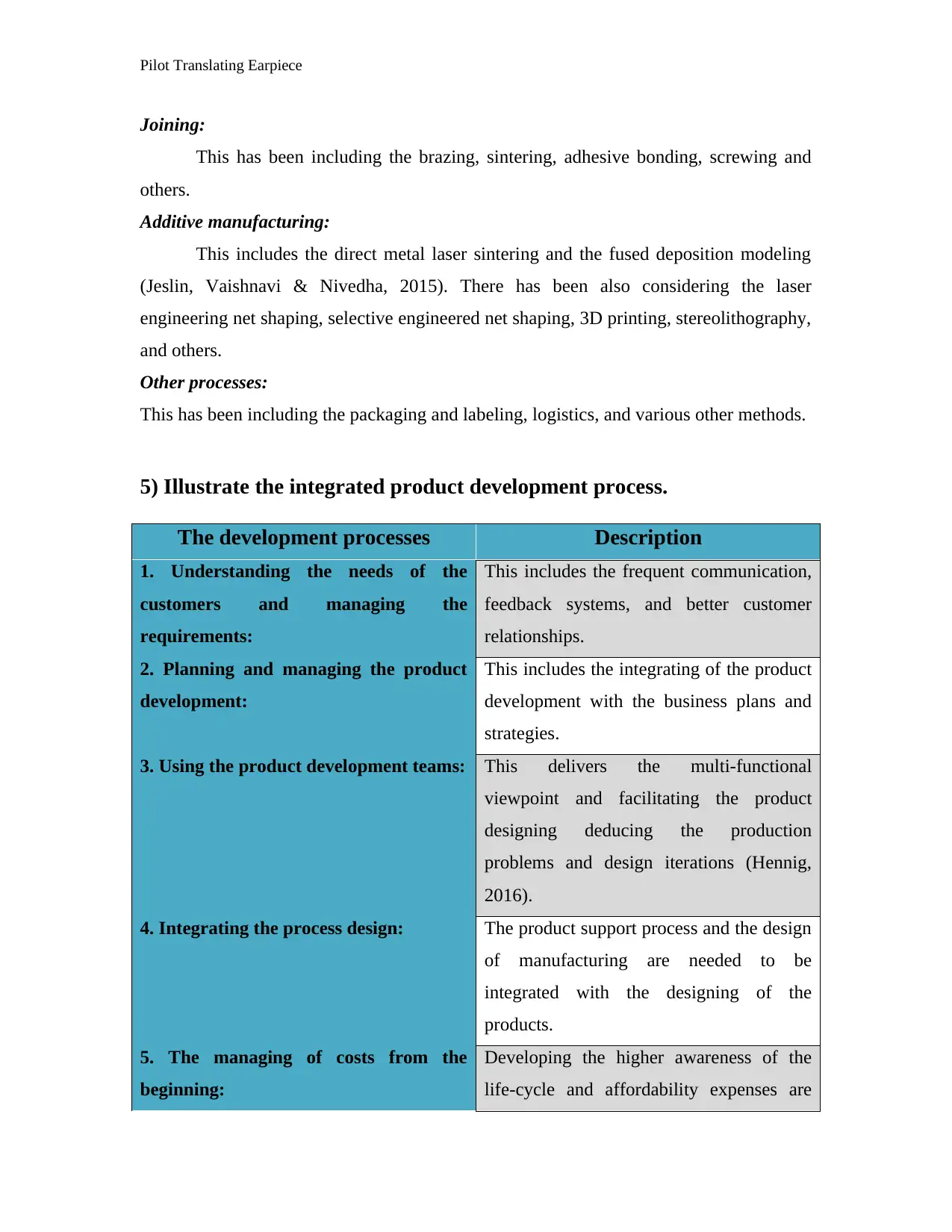
Pilot Translating Earpiece
Joining:
This has been including the brazing, sintering, adhesive bonding, screwing and
others.
Additive manufacturing:
This includes the direct metal laser sintering and the fused deposition modeling
(Jeslin, Vaishnavi & Nivedha, 2015). There has been also considering the laser
engineering net shaping, selective engineered net shaping, 3D printing, stereolithography,
and others.
Other processes:
This has been including the packaging and labeling, logistics, and various other methods.
5) Illustrate the integrated product development process.
The development processes Description
1. Understanding the needs of the
customers and managing the
requirements:
This includes the frequent communication,
feedback systems, and better customer
relationships.
2. Planning and managing the product
development:
This includes the integrating of the product
development with the business plans and
strategies.
3. Using the product development teams: This delivers the multi-functional
viewpoint and facilitating the product
designing deducing the production
problems and design iterations (Hennig,
2016).
4. Integrating the process design: The product support process and the design
of manufacturing are needed to be
integrated with the designing of the
products.
5. The managing of costs from the
beginning:
Developing the higher awareness of the
life-cycle and affordability expenses are
Joining:
This has been including the brazing, sintering, adhesive bonding, screwing and
others.
Additive manufacturing:
This includes the direct metal laser sintering and the fused deposition modeling
(Jeslin, Vaishnavi & Nivedha, 2015). There has been also considering the laser
engineering net shaping, selective engineered net shaping, 3D printing, stereolithography,
and others.
Other processes:
This has been including the packaging and labeling, logistics, and various other methods.
5) Illustrate the integrated product development process.
The development processes Description
1. Understanding the needs of the
customers and managing the
requirements:
This includes the frequent communication,
feedback systems, and better customer
relationships.
2. Planning and managing the product
development:
This includes the integrating of the product
development with the business plans and
strategies.
3. Using the product development teams: This delivers the multi-functional
viewpoint and facilitating the product
designing deducing the production
problems and design iterations (Hennig,
2016).
4. Integrating the process design: The product support process and the design
of manufacturing are needed to be
integrated with the designing of the
products.
5. The managing of costs from the
beginning:
Developing the higher awareness of the
life-cycle and affordability expenses are
Paraphrase This Document
Need a fresh take? Get an instant paraphrase of this document with our AI Paraphraser
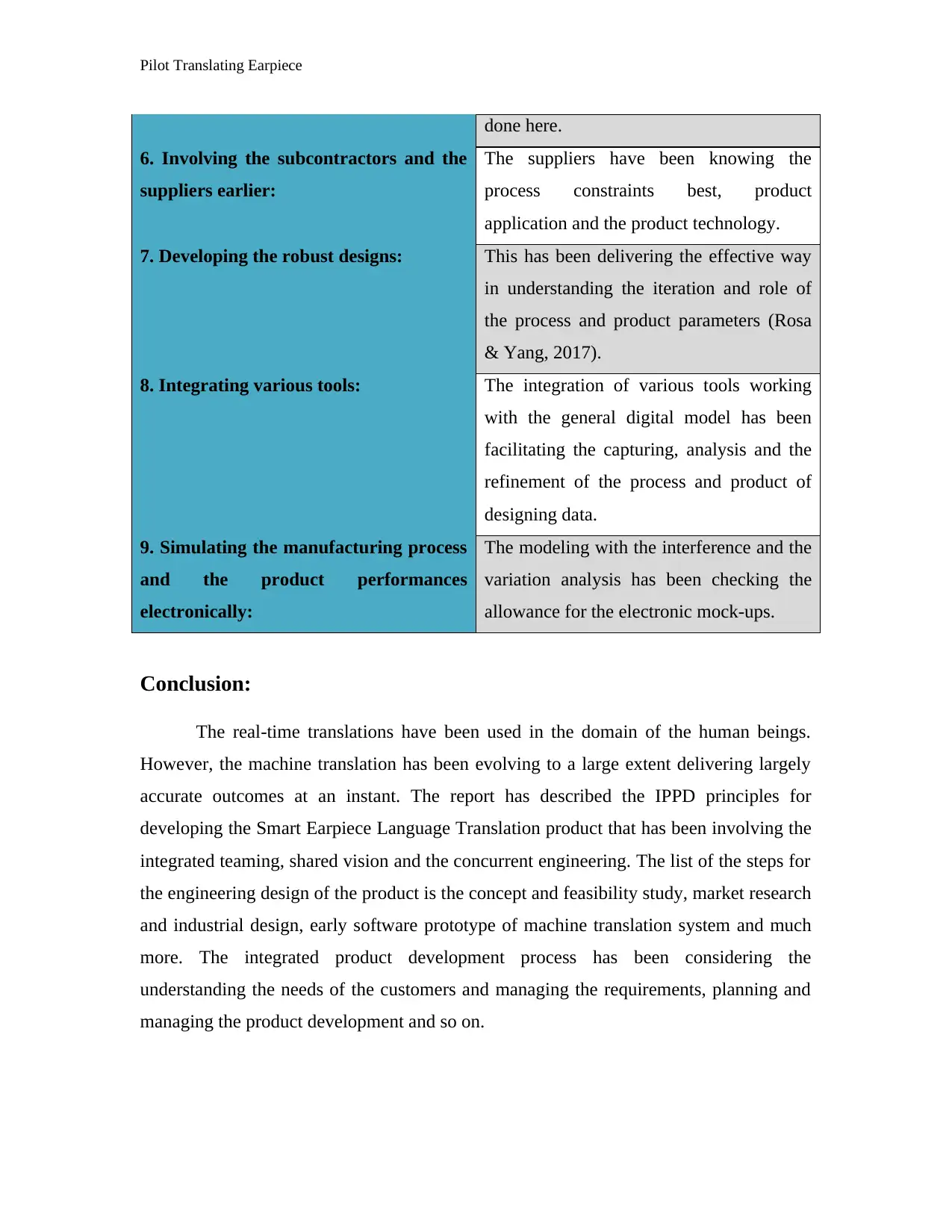
Pilot Translating Earpiece
done here.
6. Involving the subcontractors and the
suppliers earlier:
The suppliers have been knowing the
process constraints best, product
application and the product technology.
7. Developing the robust designs: This has been delivering the effective way
in understanding the iteration and role of
the process and product parameters (Rosa
& Yang, 2017).
8. Integrating various tools: The integration of various tools working
with the general digital model has been
facilitating the capturing, analysis and the
refinement of the process and product of
designing data.
9. Simulating the manufacturing process
and the product performances
electronically:
The modeling with the interference and the
variation analysis has been checking the
allowance for the electronic mock-ups.
Conclusion:
The real-time translations have been used in the domain of the human beings.
However, the machine translation has been evolving to a large extent delivering largely
accurate outcomes at an instant. The report has described the IPPD principles for
developing the Smart Earpiece Language Translation product that has been involving the
integrated teaming, shared vision and the concurrent engineering. The list of the steps for
the engineering design of the product is the concept and feasibility study, market research
and industrial design, early software prototype of machine translation system and much
more. The integrated product development process has been considering the
understanding the needs of the customers and managing the requirements, planning and
managing the product development and so on.
done here.
6. Involving the subcontractors and the
suppliers earlier:
The suppliers have been knowing the
process constraints best, product
application and the product technology.
7. Developing the robust designs: This has been delivering the effective way
in understanding the iteration and role of
the process and product parameters (Rosa
& Yang, 2017).
8. Integrating various tools: The integration of various tools working
with the general digital model has been
facilitating the capturing, analysis and the
refinement of the process and product of
designing data.
9. Simulating the manufacturing process
and the product performances
electronically:
The modeling with the interference and the
variation analysis has been checking the
allowance for the electronic mock-ups.
Conclusion:
The real-time translations have been used in the domain of the human beings.
However, the machine translation has been evolving to a large extent delivering largely
accurate outcomes at an instant. The report has described the IPPD principles for
developing the Smart Earpiece Language Translation product that has been involving the
integrated teaming, shared vision and the concurrent engineering. The list of the steps for
the engineering design of the product is the concept and feasibility study, market research
and industrial design, early software prototype of machine translation system and much
more. The integrated product development process has been considering the
understanding the needs of the customers and managing the requirements, planning and
managing the product development and so on.
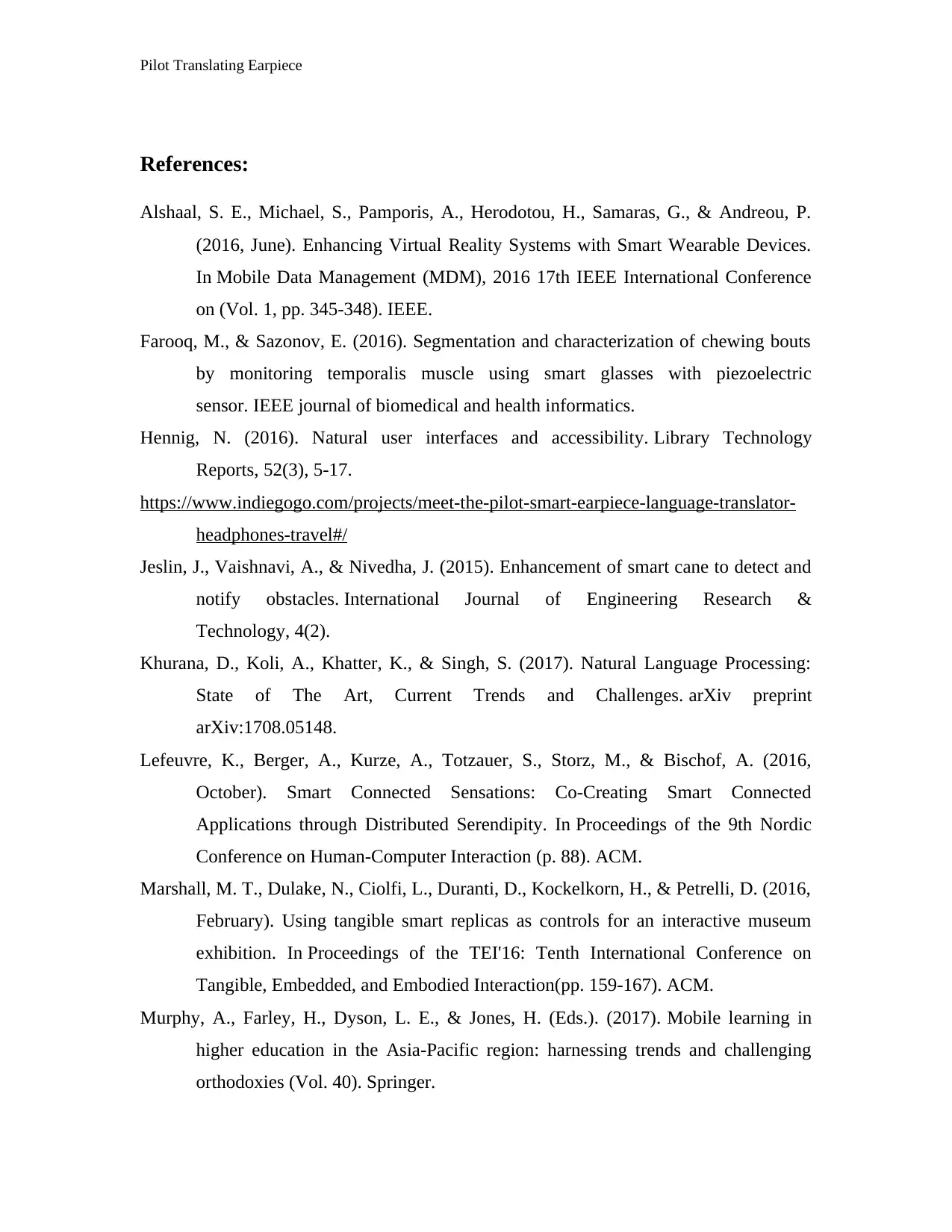
Pilot Translating Earpiece
References:
Alshaal, S. E., Michael, S., Pamporis, A., Herodotou, H., Samaras, G., & Andreou, P.
(2016, June). Enhancing Virtual Reality Systems with Smart Wearable Devices.
In Mobile Data Management (MDM), 2016 17th IEEE International Conference
on (Vol. 1, pp. 345-348). IEEE.
Farooq, M., & Sazonov, E. (2016). Segmentation and characterization of chewing bouts
by monitoring temporalis muscle using smart glasses with piezoelectric
sensor. IEEE journal of biomedical and health informatics.
Hennig, N. (2016). Natural user interfaces and accessibility. Library Technology
Reports, 52(3), 5-17.
https://www.indiegogo.com/projects/meet-the-pilot-smart-earpiece-language-translator-
headphones-travel#/
Jeslin, J., Vaishnavi, A., & Nivedha, J. (2015). Enhancement of smart cane to detect and
notify obstacles. International Journal of Engineering Research &
Technology, 4(2).
Khurana, D., Koli, A., Khatter, K., & Singh, S. (2017). Natural Language Processing:
State of The Art, Current Trends and Challenges. arXiv preprint
arXiv:1708.05148.
Lefeuvre, K., Berger, A., Kurze, A., Totzauer, S., Storz, M., & Bischof, A. (2016,
October). Smart Connected Sensations: Co-Creating Smart Connected
Applications through Distributed Serendipity. In Proceedings of the 9th Nordic
Conference on Human-Computer Interaction (p. 88). ACM.
Marshall, M. T., Dulake, N., Ciolfi, L., Duranti, D., Kockelkorn, H., & Petrelli, D. (2016,
February). Using tangible smart replicas as controls for an interactive museum
exhibition. In Proceedings of the TEI'16: Tenth International Conference on
Tangible, Embedded, and Embodied Interaction(pp. 159-167). ACM.
Murphy, A., Farley, H., Dyson, L. E., & Jones, H. (Eds.). (2017). Mobile learning in
higher education in the Asia-Pacific region: harnessing trends and challenging
orthodoxies (Vol. 40). Springer.
References:
Alshaal, S. E., Michael, S., Pamporis, A., Herodotou, H., Samaras, G., & Andreou, P.
(2016, June). Enhancing Virtual Reality Systems with Smart Wearable Devices.
In Mobile Data Management (MDM), 2016 17th IEEE International Conference
on (Vol. 1, pp. 345-348). IEEE.
Farooq, M., & Sazonov, E. (2016). Segmentation and characterization of chewing bouts
by monitoring temporalis muscle using smart glasses with piezoelectric
sensor. IEEE journal of biomedical and health informatics.
Hennig, N. (2016). Natural user interfaces and accessibility. Library Technology
Reports, 52(3), 5-17.
https://www.indiegogo.com/projects/meet-the-pilot-smart-earpiece-language-translator-
headphones-travel#/
Jeslin, J., Vaishnavi, A., & Nivedha, J. (2015). Enhancement of smart cane to detect and
notify obstacles. International Journal of Engineering Research &
Technology, 4(2).
Khurana, D., Koli, A., Khatter, K., & Singh, S. (2017). Natural Language Processing:
State of The Art, Current Trends and Challenges. arXiv preprint
arXiv:1708.05148.
Lefeuvre, K., Berger, A., Kurze, A., Totzauer, S., Storz, M., & Bischof, A. (2016,
October). Smart Connected Sensations: Co-Creating Smart Connected
Applications through Distributed Serendipity. In Proceedings of the 9th Nordic
Conference on Human-Computer Interaction (p. 88). ACM.
Marshall, M. T., Dulake, N., Ciolfi, L., Duranti, D., Kockelkorn, H., & Petrelli, D. (2016,
February). Using tangible smart replicas as controls for an interactive museum
exhibition. In Proceedings of the TEI'16: Tenth International Conference on
Tangible, Embedded, and Embodied Interaction(pp. 159-167). ACM.
Murphy, A., Farley, H., Dyson, L. E., & Jones, H. (Eds.). (2017). Mobile learning in
higher education in the Asia-Pacific region: harnessing trends and challenging
orthodoxies (Vol. 40). Springer.
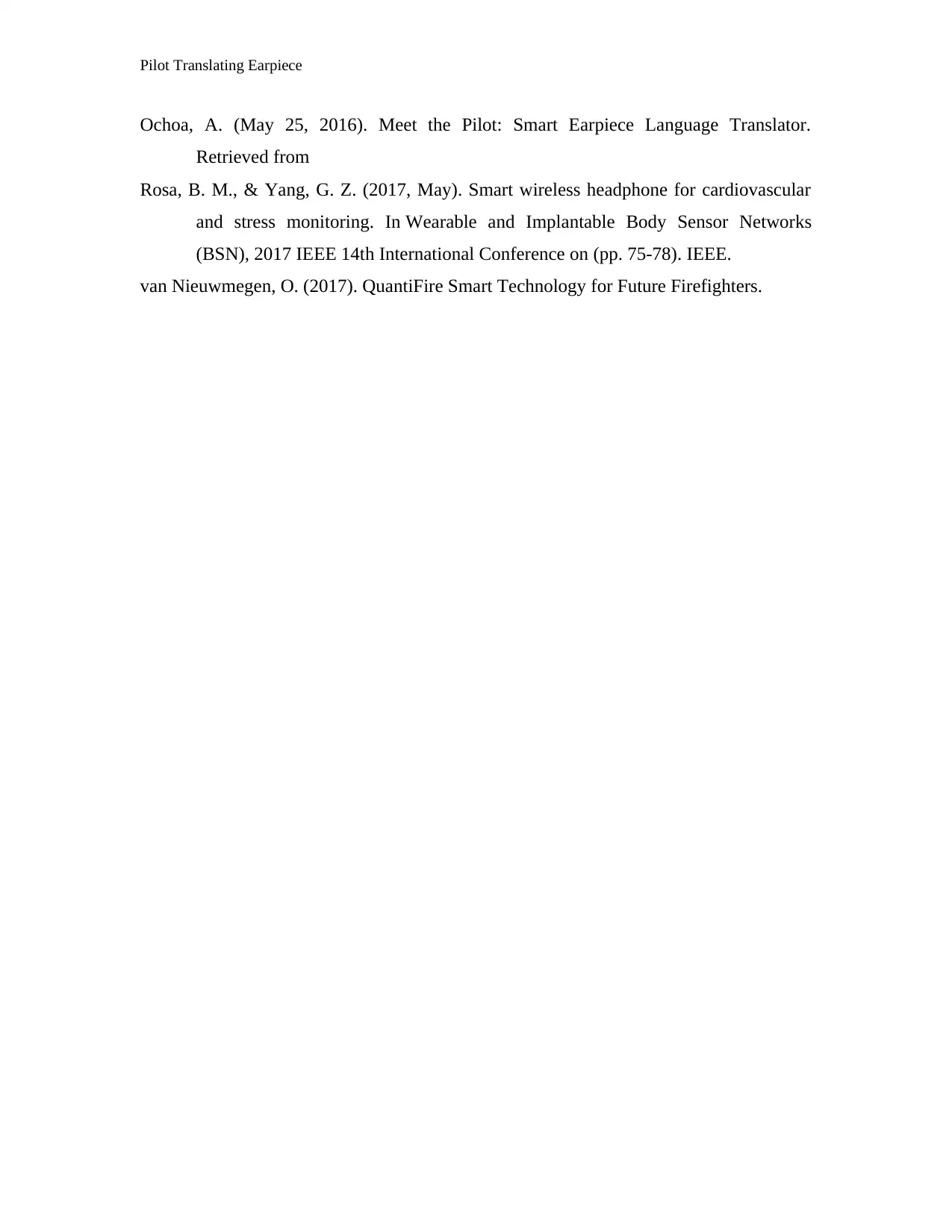
Pilot Translating Earpiece
Ochoa, A. (May 25, 2016). Meet the Pilot: Smart Earpiece Language Translator.
Retrieved from
Rosa, B. M., & Yang, G. Z. (2017, May). Smart wireless headphone for cardiovascular
and stress monitoring. In Wearable and Implantable Body Sensor Networks
(BSN), 2017 IEEE 14th International Conference on (pp. 75-78). IEEE.
van Nieuwmegen, O. (2017). QuantiFire Smart Technology for Future Firefighters.
Ochoa, A. (May 25, 2016). Meet the Pilot: Smart Earpiece Language Translator.
Retrieved from
Rosa, B. M., & Yang, G. Z. (2017, May). Smart wireless headphone for cardiovascular
and stress monitoring. In Wearable and Implantable Body Sensor Networks
(BSN), 2017 IEEE 14th International Conference on (pp. 75-78). IEEE.
van Nieuwmegen, O. (2017). QuantiFire Smart Technology for Future Firefighters.
1 out of 10
Related Documents
Your All-in-One AI-Powered Toolkit for Academic Success.
+13062052269
info@desklib.com
Available 24*7 on WhatsApp / Email
![[object Object]](/_next/static/media/star-bottom.7253800d.svg)
Unlock your academic potential
© 2024 | Zucol Services PVT LTD | All rights reserved.




